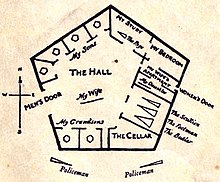A parallel universe is a hypothetical self-contained reality co-existing with one's own. A specific group of parallel universes is called a "multiverse", although this term can also be used to describe the possible parallel universes that constitute reality. While the terms "parallel universe" and "alternative reality" are generally synonymous and can be used interchangeably in most cases, there is sometimes an additional connotation implied with the term "alternative reality" that implies that the reality is a variant of our own. The term "parallel universe" is more general, without any connotations implying a relationship, or lack of relationship, with our own universe. A universe where the very laws of nature are different – for example, one in which there are no Laws of Motion – would in general count as a parallel universe but not an alternative reality and a concept between both fantasy world and earth.
Science fiction
While technically incorrect, and looked down upon by hard science-fiction fans and authors, the idea of another "dimension" has become synonymous with the term "parallel universe". The usage is particularly common in movies, television and comic books and much less so in modern prose science fiction. The idea of a parallel world was first introduced in comic books with the publication of Flash #123 - "Flash of Two Worlds".
In written science fiction, "new dimensions" more commonly – and more accurately – refer to additional coordinate axes, beyond the three spatial axes with which we are familiar. By proposing travel along these extra axes, which are not normally perceptible, the traveler can reach worlds that are otherwise unreachable and invisible.
In 1884, Edwin A. Abbott wrote the seminal novel exploring this concept called Flatland: A Romance of Many Dimensions. It describes a world of two dimensions inhabited by living squares, triangles, and circles, called Flatland, as well as Pointland (0 dimensions), Lineland (1 dimension), and Spaceland (three dimensions) and finally posits the possibilities of even greater dimensions. Isaac Asimov, in his foreword to the Signet Classics 1984 edition, described Flatland as "The best introduction one can find into the manner of perceiving dimensions."
In 1895, The Time Machine by H. G. Wells used time as an additional "dimension" in this sense, taking the four-dimensional model ofclassical physics and interpreting time as a space-like dimension in which humans could travel with the right equipment. Wells also used the concept of parallel universes as a consequence of time as the fourth dimension in stories like The Wonderful Visit and Men Like Gods, an idea proposed by the astronomer Simon Newcomb, who talked about both time and parallel universes; "Add a fourth dimension to space, and there is room for an indefinite number of universes, all alongside of each other, as there is for an indefinite number of sheets of paper when we pile them upon each other".

